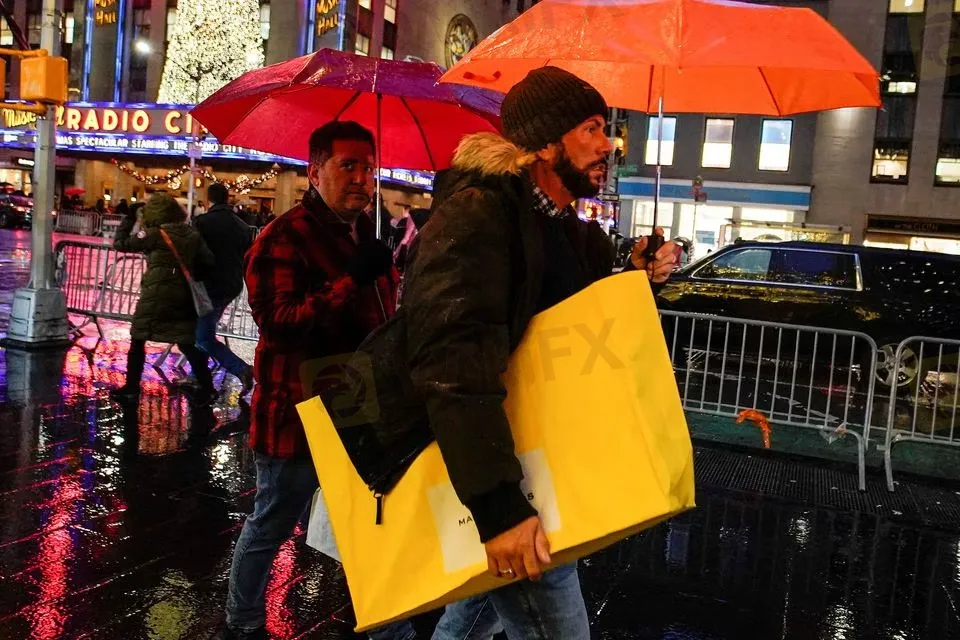简体中文
繁體中文
English
Pусский
日本語
ภาษาไทย
Tiếng Việt
Bahasa Indonesia
Español
हिन्दी
Filippiiniläinen
Français
Deutsch
Português
Türkçe
한국어
العربية
Strong U.S Economic Growth Expected In The Fourth Quarter, Outlook Darkening
Abstract:The U.S. economy likely maintained a strong pace of growth in the fourth quarter as consumers boosted spending on goods, but momentum appears to have slowed considerably towards the end of the year, with higher interest rates eroding demand.

The U.S. economy likely maintained a strong pace of growth in the fourth quarter as consumers boosted spending on goods, but momentum appears to have slowed considerably towards the end of the year, with higher interest rates eroding demand.
The Commerce Department's advanced fourth-quarter gross domestic product report on Thursday could mark the last quarter of solid growth before the lagged effects of the Federal Reserve's fastest monetary policy tightening cycle since the 1980s kick in. Most economists expect a recession by the second half of the year, though mild compared to previous downturns.
Retail sales have weakened sharply over the last two months and manufacturing looks to have joined the housing market in a recession. While the labor market remains strong, business sentiment continues to sour, which could eventually hurt hiring.
“This looks like it could be the last really positive, strong quarterly print we'll see for a while,” said Sam Bullard, a senior economist at Wells Fargo Securities in Charlotte, North Carolina. “Markets and most people will look through this number. More recent data are suggesting that economic momentum is continuing to slow.”
According to a Reuters survey of economists, GDP growth likely increased at a 2.6% annualized rate last quarter after accelerating at a 3.2% pace in the third quarter. Estimates ranged from a 1.1% rate to a 3.7% pace.
Robust second-half growth would erase the 1.1% contraction in the first six months of the year.
Growth for the full year is expected to come in at around 2.1%, down from the 5.9% logged in 2021. The Fed last year raised its policy rate by 425 basis points from near zero to a 4.25%-4.50% range, the highest since late 2007.
Consumer spending, which accounts for more than two-thirds of U.S. economic activity, is expected to have grown at a pace faster than the 2.3% rate notched in the third quarter. That would mostly reflect a surge in goods spending at the start of the quarter.
Spending has been underpinned by labor market resilience as well as excess savings accumulated during the COVID-19 pandemic. But demand for long-lasting manufactured goods, which are mostly bought on credit, has fizzled and some households, especially lower income, have depleted their savings.
Economic growth also likely received a lift from business spending on equipment, intellectual property, and nonresidential structures. But with demand for goods tanking, business spending also lost some luster as the fourth quarter ended.
Despite the clear signs of a weak handover to 2023, some economists are cautiously optimistic that the economy will skirt an outright recession, but rather suffer a rolling downturn, where sectors decline in turn rather than all at once.
ROLLING RECESSION
They argue that monetary policy now acts with a shorter lag than was previously the case because of advances in technology and the U.S. central bank's transparency, which they said resulted in financial markets and the real economy acting in anticipation of rate hikes.
“We will continue to have positive GDP numbers,” said Sung Won Sohn, a finance and economics professor at Loyola Marymount University in Los Angeles. “The reason is sectors are taking turns going down, and not simultaneously declining. The rolling recession began with housing and now we are seeing the next phase which is consumption related.”
Indeed, with demand for goods slumping, factory production has declined sharply for two straight months. Job cuts in the technology industry were also seen as flagging cutbacks in capital spending by businesses.
While residential investment likely suffered its seventh straight quarterly decline, which would be the longest such streak since the collapse of the housing bubble triggered the Great Recession, there are signs the housing market could be stabilizing. Mortgage rates have been trending lower as the Fed slows the pace of its rate hikes.
Inventory accumulation was seen adding to GDP last quarter, but with demand slowing, businesses are likely to focus on reducing stock in their warehouse rather than placing new orders, which would undercut growth in the quarters ahead.
Trade, which accounted for the bulk of GDP growth in the third quarter, was seen either making a small contribution or subtracting from GDP growth. Strong growth is expected from government spending.
While the labor market thus far has shown remarkable resilience, economists argue that deteriorating business conditions will force companies to slow hiring and lay off workers.
Companies outside the technology industry as well as interest-rate-sensitive sectors like housing and finance are hoarding workers after struggling to find labor during the pandemic.
A separate report from the Labor Department on Thursday is likely to show initial claims for state unemployment benefits rose to a seasonally adjusted 205,000 for the week ended Jan. 21, from 190,000 in the prior week, according to a Reuters survey of economists.
“We expect initial jobless claims will eventually start to turn back up after their recent drop, consistent with an eventual downturn in payrolls and a rise in the unemployment rate,” said Kevin Cummins, chief economist at NatWest Markets in Stamford, Connecticut. “In turn, we expect spending to slow as consumers will be less willing to run down savings in the face of a deteriorating labor market.”

Disclaimer:
The views in this article only represent the author's personal views, and do not constitute investment advice on this platform. This platform does not guarantee the accuracy, completeness and timeliness of the information in the article, and will not be liable for any loss caused by the use of or reliance on the information in the article.
Read more

Close Up With WikiFX —— Take A Close Look At Amillex
With the rapid growth of global multi-asset investment markets, the differences among regional forex markets have become increasingly significant. As a forex broker information service platform operating in more than 180 countries and regions, WikiFX is dedicated to helping investors in every market identify reliable brokers. Therefore, we have launched an exclusive interview series —— "Close Up With WikiFX", offering in-depth conversations with local brokers. This series aims to dive deep into frontline markets and provide first-hand information, helping investors gain a clearer and more comprehensive understanding of quality brokers.

Seacrest Markets Exposed: Are You Facing Payout Denials and Spread Issues with This Prop Firm?
Seacrest Markets has garnered wrath from traders owing to a variety of reasons, including payout denials for traders winning trading challenges, high slippage causing losses, the lack of response from the customer support official to address withdrawal issues, and more. Irritated by these trading inefficiencies, a lot of traders have given a negative review of Seacrest Markets prop firm. In this article, we have shared some of them. Take a look!

GKFX Review: Are Traders Facing Slippage and Account Freeze Issues?
Witnessing capital losses despite tall investment return assurances by GKFX officials? Do these officials sound too difficult for you to judge, whether they offer real or fake advice? Do you encounter slippage issues causing a profit reduction on the GKFX login? Is account freezing usual at GKFX? Does the United Kingdom-based forex broker prevent you from accessing withdrawals? You are not alone! In this GKFX review guide, we have shared the complaints. Take a look!

Is Seaprimecapitals Regulated? A Complete Look at Its Safety and How It Works
The straightforward answer to this important question is no. Seaprimecapitals works as a broker without proper regulation. This fact is the most important thing any trader needs to know, because it creates serious risks for your capital and how safely the company operates. While this broker offers some good features, like the popular MetaTrader 5 platform and a low starting deposit, these benefits cannot make up for the major risks that come from having no real financial supervision. This article will give you a detailed, fact-based look at Seaprimecapitals regulation, what the company claims to do, the services it provides, and the clear differences between official information and user reviews. Our purpose is to give you the information you need to make a smart decision about the risks and benefits of working with this company.
WikiFX Broker
Latest News
Interactive Brokers Expands Access to Taipei Exchange
Simulated Trading Competition Experience Sharing
WinproFx Regulation: A Complete Guide to Its Licensing and Safety for Traders
Axi Review: A Data-Driven Analysis for Experienced Traders
INZO Regulation and Risk Assessment: A Data-Driven Analysis for Traders
Pepperstone CEO: “Taking Down Scam Sites Almost Every Day” Becomes “Depressing Daily Business”
The CMIA Capital Partners Scam That Cost a Remisier Almost Half a Million
Is Seaprimecapitals Regulated? A Complete Look at Its Safety and How It Works
eToro Cash ISA Launch Shakes UK Savings Market
Cleveland Fed's Hammack supports keeping rates around current 'barely restrictive' level
Currency Calculator



